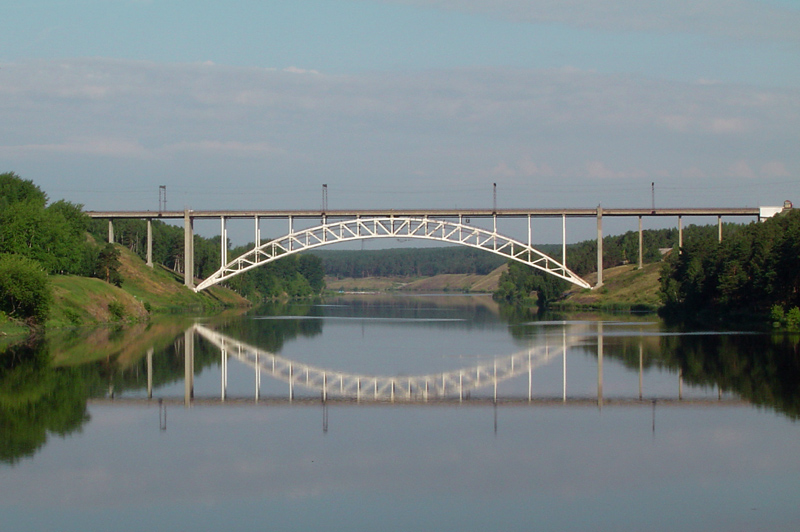|
Rail Bridge Over The Iset River, Kamensk-Uralsky
The Rail Bridge over the Iset River - is an experimental bridge over the Iset River is a unique engineering structure made according to the advanced technology of the late 1930s in Kamensk-Uralsky, Sverdlovsk oblast. The building was granted the status of regional significance on the 28th of December 2001 (the Sverdlovsk oblast Sverdlovsk Oblast ( rus, Свердловская область, Sverdlovskaya oblast) is a federal subject (an oblast) of Russia located in the Ural Federal District. Its administrative center is the city of Yekaterinburg, formerly known as S ... Government Decree № 859). The object number of cultural heritage of regional significance is 661710946850005. Architecture In 1934 the construction of the Ural Aluminum Plant began. To support the plant, the Yekaterinburg-Shadrinsk-Kurgan railway line running through Kamensk, but located north of the plant at a considerable distance, was used. By 1938 a project was developed for supplying vehicles through ... [...More Info...] [...Related Items...] OR: [Wikipedia] [Google] [Baidu] |
Kamensk-Uralsky
Kamensk-Uralsky (russian: Ка́менск-Ура́льский) is a city in Sverdlovsk Oblast, Russia, located at the confluence of the Kamenka and Iset Rivers ( Ob's basin). Population: 173,000 (1972); 51,000 (1939). History Kamensky Zavod was founded in the late 17th century as a settlement next to the cast iron smelting factory and foundry, commissioned on October 15, 1701. For the first two centuries of existence it was known for its cannons. First schools opened in Kamensk in 1724. The cast iron smelting factory was rebuilt in 1825–1829. Railway traffic started on December 6, 1885. The first library opened in 1899. In 1934, Sinarsky Pipe Works was established. In 1939, Ural Aluminum Factory was established. Kamensk was granted city status in 1935 and renamed Kamensk-Uralsky in 1940. Administrative and municipal status Within the framework of the administrative divisions, Kamensk-Uralsky serves as the administrative center of Kamensky District, even th ... [...More Info...] [...Related Items...] OR: [Wikipedia] [Google] [Baidu] |
Sverdlovsk Oblast
Sverdlovsk Oblast ( rus, Свердловская область, Sverdlovskaya oblast) is a federal subject (an oblast) of Russia located in the Ural Federal District. Its administrative center is the city of Yekaterinburg, formerly known as Sverdlovsk. Its population is 4,297,747 (according to the 2010 Census). Geography Most of the oblast is spread over the eastern slopes of the Middle and North Urals and the Western Siberian Plain. Only in the southwest does the oblast stretch onto the western slopes of the Ural Mountains. The highest mountains all rise in the North Urals, Konzhakovsky Kamen at and Denezhkin Kamen at . The Middle Urals is mostly hilly country with no discernible peaks; the mean elevation is closer to above sea level. Principal rivers include the Tavda, the Tura, the Chusovaya, and the Ufa, the latter two being tributaries of the Kama. Sverdlovsk Oblast borders with, clockwise from the west, Perm Krai, the Komi Republic, Khanty–Mansi Autonomous Okru ... [...More Info...] [...Related Items...] OR: [Wikipedia] [Google] [Baidu] |
Tourist Attractions In Sverdlovsk Oblast
Tourism is travel for pleasure or business; also the theory and practice of touring, the business of attracting, accommodating, and entertaining tourists, and the business of operating tours. The World Tourism Organization defines tourism more generally, in terms which go "beyond the common perception of tourism as being limited to holiday activity only", as people "travelling to and staying in places outside their usual environment for not more than one consecutive year for leisure and not less than 24 hours, business and other purposes". Tourism can be Domestic tourism, domestic (within the traveller's own country) or International tourism, international, and international tourism has both incoming and outgoing implications on a country's balance of payments. Tourism numbers declined as a result of a strong economic slowdown (the late-2000s recession) between the second half of 2008 and the end of 2009, and in consequence of the outbreak of the 2009 2009 flu pandemic, H1N1 ... [...More Info...] [...Related Items...] OR: [Wikipedia] [Google] [Baidu] |


